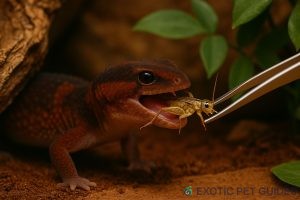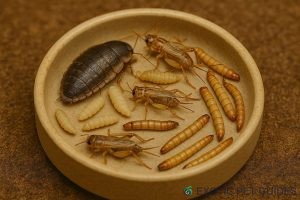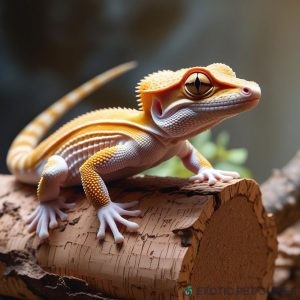🧭 Introduction
Feeding your African Fat-Tailed Gecko (Hemitheconyx caudicinctus) properly is the foundation of its long-term health. These insectivorous reptiles rely on a steady supply of gut-loaded insects, calcium, and hydration — but feeding frequency, supplement timing, and insect variety all matter more than you might think.
In this guide, you’ll learn:
- The best food options for fat-tailed geckos
- How often to feed juveniles vs adults
- Calcium, vitamin, and hydration best practices
- Feeding do’s and don’ts

🦗 What Do African Fat-Tailed Geckos Eat?
They are strictly insectivores, meaning no fruit, veggies, or pellets.
Safe & Nutritious Insects:
| Insect Type | Notes |
|---|---|
| Crickets | Affordable, good movement stimulus |
| Dubia Roaches | High-protein, low-chitin, slow movers |
| Mealworms | Easy to keep, not ideal as staple |
| Black Soldier Fly Larvae (BSFL) | High in calcium |
| Waxworms | Treat only – high fat |
| Hornworms/Silkworms | Occasional treats, hydrating |
🧠 Variety is key — don’t rely only on one insect type.

🗓️ Feeding Schedule
| Age Group | Feeding Frequency | Quantity |
|---|---|---|
| Juvenile (0–6 months) | Daily | 4–6 small insects/day |
| Subadult (6–12 months) | Every 1–2 days | 5–6 medium insects/meal |
| Adult (12+ months) | Every 2–3 days | 6–8 medium/large insects |
✅ Feed at night or early evening, when geckos are most active.
⚖️ Portion Control & Obesity
Fat-tailed geckos store fat in their tails, but overfeeding can still cause obesity, especially with fatty treats like waxworms.
Healthy Tail Appearance:
- Full and rounded
- Not too bulging
- No visible bones at base

🧂 Supplement Schedule (Calcium + Vitamins)
Since they don’t get natural sunlight, you must supplement insects:
| Supplement Type | Frequency |
|---|---|
| Calcium (no D3) | Every feeding |
| Calcium with D3 | 1x/week (only if no UVB light used) |
| Multivitamin | 1x/week |
How to Use:
- Dust insects lightly, don’t overcoat
- Rotate supplements to avoid overdosing
- Offer a small calcium dish in the enclosure (optional)
💧 Hydration Tips
Fat-Tails may rarely drink from a dish, so hydration comes from:
- Daily misting
- Moist hide with damp moss
- Juicy feeder insects (like hornworms)
Always provide:
- Shallow water dish, changed daily
- Humid hide at 50–70% humidity
🚫 What NOT to Feed
Avoid these foods at all costs:
- Wild-caught insects (may carry parasites/pesticides)
- Fruit, vegetables, baby food (they’re obligate insectivores)
- Large insects (bigger than space between gecko’s eyes = choking risk)
- Fireflies or lightning bugs (toxic)
🧼 Feeding Tips & Hygiene
- Use feeding tongs for better control
- Remove uneaten insects after 15–30 minutes
- Feed in a designated area or dish to monitor appetite
- Clean feeding dishes daily to prevent mold or bacteria
🧪 Signs of Healthy Feeding
A healthy Fat-Tail will:
- Strike insects confidently
- Defecate regularly (every 1–3 days)
- Maintain good body weight
- Show interest in food at night
If your gecko refuses food for more than 1 week:
- Check temperatures & humidity
- Ensure insects are appropriately sized
- Rule out stress from new environment
- Consult an exotic vet if appetite doesn’t return